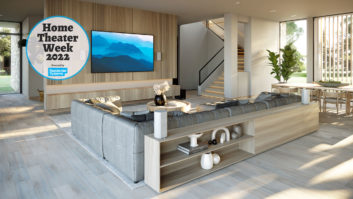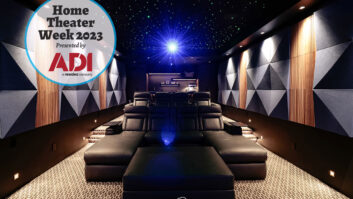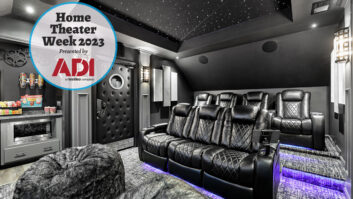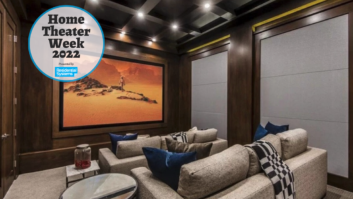Kudos: Incredibly immersive, cohesive surround envelopment with pinpoint imaging; effortlessly delivers massive SPLs; flexible design configurations
Concerns: Would have liked a bit more bass wallop
Finding the right speaker and amplifier pairing to make a home theater system sound its best can be a tricky proposition. And finding a successful synergy can often be an equal measure of past experience, guesswork, trial-and-error, and just blind luck.
But even when you do manage to find that perfect speaker and amplifier marriage, something else can rear its ugly head to turn it all to rubbish: the room where the system is installed. The exact surround system that sounds so terrific in your showroom might be a mess in the customer’s room, leaving them wondering why it never sounds as fantastic as it did when they heard the initial demo.
The solution, of course, is controlling as much of the audio signal chain as possible and tightly integrating the performance between the amplifiers and speakers, which is exactly what dARTS has been doing since 2005. Previously a part of the Phase Technology brand, dARTS – an acronym for Digital Audio Reference Theater System – is now its own brand and part of the MSE Audio family, which also includes Induction Dynamics, Phase Technology, and Rockustics among others.
Ken Hecht, son of company founder, Bill Hecht, and the man now in charge of dARTS, came to my home to setup, install, and calibrate my review system. (And also take me out to a nice seafood dinner. Thanks, Ken!) While doing so, he shared some of the company’s fascinating history and legacy that included his father helping with the development of Cinemascope stereo technology for theatrical projection back in the early ’50s, as well as developing and patenting multiple audio technologies, including the soft dome tweeter that is still widely in use! Quite a pedigree to be sure.
The dARTS “promise” is the system will deliver “sound perfection, regardless of the room’s acoustics.” A lofty claim to be sure, but the company is able to make that claim by doing a few unique things. First, all dARTS systems are driven by the company’s DP-4000-IA digital/programmable amplifier. This behemoth puts out 250-watts across 16-channels – 4000 watts total! – and has known performance characteristics to deliver identical performance at every install. It is also DSP programmable, handling all crossover, time alignment, and more for every driver in the system. Second, every driver and then every system is custom calibrated in dARTS’ anechoic chamber to within 1/2-dB of their reference response curve. Thus, every dARTS system leaves the factory sounding identical. Finally, after installation, every dARTS system is measured and calibrated with a custom version of Audyssey’s Multi-EQ XT room correction software and pro calibration kit. This was co-developed between dARTS and Audyssey in 2005 and uses an implementation unique to the dARTS system. Since the system’s performance characteristics are known to within 1/2-dB, Audyssey is only correcting for the room’s effects on the sound, thus returning the system to the performance curve that left the factory.
There are two different dARTS Series; the 535 reviewed here and the larger 660. These systems are based on room size, with the 535 meant for rooms ranging from 2500 – 8000 cubic feet and the 660 for rooms 5000 – 18,000. Both systems are designed to deliver a minimum of 105 dB SPL (THX’s reference) at every seat in their respective room sizes. Within either series are a choice of speaker options ranging from freestanding (which includes a nice gloss black finish), custom box, in-wall, and in-ceiling, with all speakers using dARTS custom designed and built drivers.
DIW-535-LCR
DIW-535-LCR with Grille
DCB-535-LR
DCB-535-LR with Grille
DCB 112 SUB
DCB-535-C
DCB-535-C with Grille
My 5.2.2 review system was comprised of a combination of different models across the 535 series, both to prove the system’s design flexibility as well as to demonstrate how cohesively the models perform together. Up front I had an LCR complement of the Custom Box series. These speakers have what I’d call an industrial/professional-looking finish, being flat black cabinets with a semi-rough, pebbly finish. The Custom Box models are intended to be placed “out of sight” such as in a baffle wall behind a perforated screen or in cabinetry. The company will also custom build models to fit specific install applications. What I really noticed about the speaker is how solid and inert the cabinet is; giving them a firm wrap with my knuckles produced just a dull thud. All LCRs feature a 1.125-inch soft dome tweeter and dual 5.25-inch three-layer composite woofers.
Surround speakers utilized the DP1051IW in-wall speakers that feature the same driver complement as the front channels. These installed in custom-built “walls” I fabricated for in-wall speaker testing, allowing us to ideally locate and position the speakers in my test room. These in-walls utilize another bit of dARTS patented tech called Positive Clamping, which uses a full-length metal clamp with isolating gaskets to ensure a tight, secure fit without causing any wall vibrations. To add height speakers without retrofitting wiring and cutting holes in my ceiling, Ken brought some scaffolding that he fabricated in the room over and just ahead of my seating position that supported the DC-660-R in-ceiling speakers at a height of about 8-feet above the floor. Bass chores were handled by a pair of subs, each featuring a roughly 15-inch cube footprint, with 12-inch active and passive drivers driven by an internal 500-watt amplifier.
Also by John Sciacca: Review: Control4 Triad AMS-8 and AMP-8
Another interesting aspect of the speakers that plays both into their sonic performance and the wiring requirements is that, unlike virtually every other passive speaker design out there, none of these speakers feature internal crossovers. Instead, all of the frequency separation is handled digitally in the amplifier. This means bi-wiring every speaker with 4-conductor wiring to drive both the woofer and tweeter, except the center channel, which is a 2.5-channel design requiring six speaker wires. (This design is said to minimize lobing for better frequency response across a larger variety of seats.)
Thus, you can see how quickly all 16 channels on the DP4000IA amplifier get taken up. In fact, seven is the maximum number of speakers that can be connected to one amp, either in a traditional 7-channel or 5.2-channel arrangement. Going larger requires adding additional amplifiers, with the system scalable to accommodate as many channels as your heart, wallet, and Trinnov processor can handle. The amp accepts both unbalanced RCA and balanced XLR connections, and can either power on via 12-volt trigger or when it senses a signal. My Marantz AV8802A served as the pre-amp processor for the review.
Following the wiring, setup, and connections, it was time to run the Audyssey Multi-EQ XT Pro calibration. This process will be familiar to anyone who has used Audyssey’s Pro Calibration Kit before (review available at residentialsystems.com) and allows taking up to 32 measurements in a room. Following the measurements, the results are downloaded into the DP-4000-IA’s DSP, and speaker distances and channel levels are manually entered into the pre-amp being used.
The first clip we played was “Leaf” from the Dolby Atmos demo disc; a clip likely familiar to anyone that has ever experienced an Atmos demo. I’ve heard this clip dozens of times on numerous systems, and the dARTS system immediately impressed me with its envelopment, letting me clearly track the leaf as it swirled around the room and rustled overhead. What was most amazing was how it traveled behind me even though there were no surround back speakers; a testament to the power of the dARTS speaker integration as well as the object-tracking capabilities of Atmos.
The second scene we cued up was the blizzard from Everest. Here snow pelted and swirled around the listening position, battering you from all angles, while a relentless wind howled. Even at extreme volume levels, the soundscape remained cohesive and intense without being overbearing, and dialog remained clear and precise.
You know how it is when you get a major component upgrade in your system, and you just go racing through your library of movie and music titles, re-sampling all your old favorites so you can experience them on your new kit? Yeah. That’s basically how I spent many hours with the dARTS system, just jumping from once scene/film on my Kaleidescape to the next.
Repeatedly, the system distinguished itself by delivering terrific dimensionality and immersion, placing me in a solid bubble of sounds able to locate a sound specifically at any point in the room. I also found myself noticing smaller, more delicate and minute sounds that normally go unnoticed. Small background conversations, atmospheric effects like wind rustling leaves, or the after effects of an explosion as glass and debris scatter.
It’s difficult to select standout audio moments, because the dARTS system performed so fantastically with everything I threw at it, but I will share some highlights. First, was the 2012 film Red Tails. This was executive produced by George Lucas and follows the Tuskegee Airmen proving their worth in the skies of World War II Europe. Sadly, the dARTS system could do nothing to improve the dreadful dialog – instead delivering every line in painful clarity – but the German Blu-ray disc features an Auro-3D 11.1 soundtrack that is reference in every sense. The dogfight scenes are fast and furious, and the system dutifully tracked every P-51 Mustang as they raced around the room, zipping overhead, tearing along the sides and through the back wall, guns blazing.
Anyone doubting audio’s powerful role in film needs to watch IT on a dARTS system. This is one of the most immersive – and flat-out creepy – audio mixes maybe ever, clearly demonstrating that scares are comprised of far more than just what you see. From the opening seconds the height and surround channels are used to terrific effect to throw you off-balance and just creep you out. Every second in the Neibolt Street house is full of sonic freights and atmospheric unease, with creeks, groans, buzzes, and whispers engulfing you and adding to the onscreen terror.
Gravity is another film that has an incredibly layered and immersive audio mix. Throughout the early spacewalk scenes, voices from the astronauts and Houston swirl around the ceiling and surround channels, moving in relation to the characters on screen. There is also tons of other bits of chatter and radio transmissions that place you in the scene, that can be lost on lesser systems. Not only did the dARTS system deliver all this info, and when the debris wrecks the space station, dARTS system envelopes you in the action
If I had one nit to pick with the dARTS performance, it would be that the bass didn’t deliver that in-the-chest slam that adds another dimension to the experience. The bass was loud, tight, and deep, but it didn’t produce the concussive bass waves that take home theater to the next level. If I were buying this system, I’d audition the larger subs. Also, take that with a grain of “my regular system includes an SVS SB16-ULTRA and a Definitive Technology Super Cube Trinity Reference,” so my bass expectations are fairly lofty.
The dARTS system is flat out impressive, delivering on every one of its promises and a few extra to boot. Instead of feeling like I had to go in and listen for sake of this review, I looked for excuses to listen longer. Dealers looking for a repeatable, premium theater solution that offers a ton of installation flexibility should put dARTS on the top of the short list.
Contact: 855-663-5600; dartsdigitaltheater.com
Product Specs:
- Speakers available in a variety of form factors, including in-room, in-wall, and in-ceiling
- All speakers matched to within .5 dB and systems guaranteed to produce at least 105 dB SPL
- System scalable to support any number of channels; maximum seven speakers per DP4000-IA
- Custom implementation of Audyssey MultEQ Pro room calibration; requires Audyssey Pro Cal kit; measures up to 32 seating positions
- 16-channel x 250-watts (4 ohm) amplification; subwoofers feature internal 500-watt amplification
- Dimensions: DSP4000-IA – 5.625 x 17 x 17-inches (H x W x D); 21 pounds
- DP4000-IA Connections: Inputs: 8 balanced XLR, 16 Unbalance RCA, mini XLR calibration mic, 12-volt trigger; Outputs: 2 RCA line-level subwoofer, 12-volt trigger, 16-pair of 5-way speaker binding posts, detachable power cord














